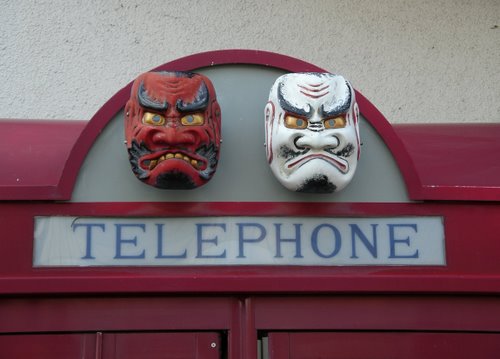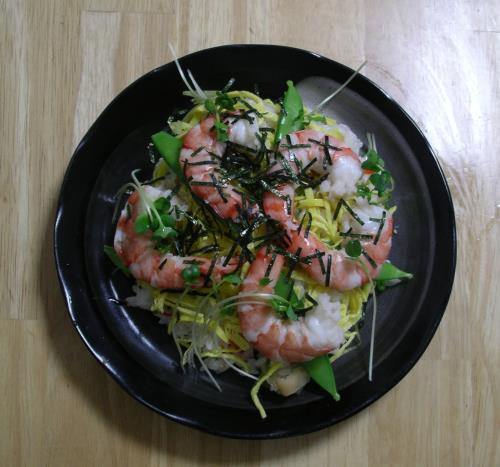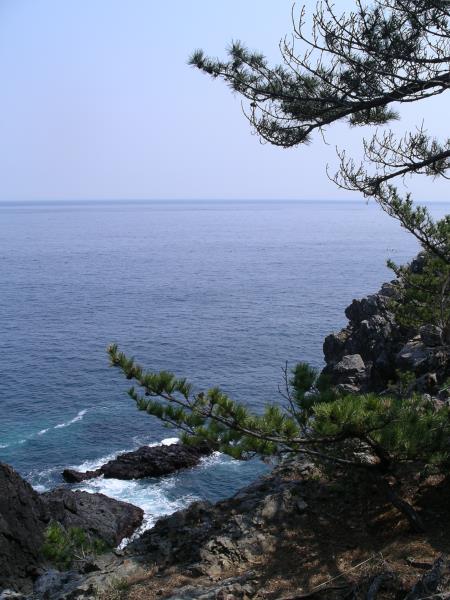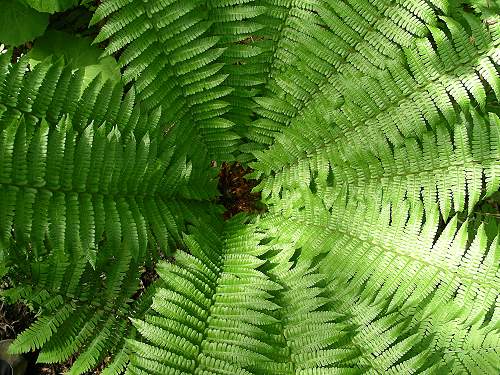Wait, what? A fall flower? But it's only the end of July! Yes, she said, it's a fall flower, one that is around for a long time, from late summer through autumn.
Tohoku is known for having short summers and long, harsh winters, so it makes sense that the transitional flowers show up earlier than in other parts of Japan. Even so, July seems a bit early for the harbingers of autumn. Looking on the bright side, though, after seven summers in Washington and one here, the prospect of not having August weather is quite welcome.
These ones are growing in a neighbor's yard. They also grow wild along the mountain roads in the area.
To get there, all you have to do is get in your car and drive through clouds of poisonous gas, just beyond the signs warning you to keep moving, lest you be overcome and die.
Totally worth the 900 yen.

You might not want to try stealing 100 yen coins from the phones inside.
Until last night, when the glasses started rattling and the ceiling lights started bouncing, the prelude to a whooshing roar as our second big earthquake intensified. The quake registered as a 6.8 on the Richter scale, with its epicenter about 65 km from here, east of Morioka. Areas close to the epicenter had landslides and some fires; Kitakami escaped relatively unscathed once again. JR East didn't resume train service until about 1:45 pm, but people who needed to travel simply found other ways, and we went on with our lives.
There are two attitudes frequently associated with the Japanese people. One is ganbaru �� perseverance, or striving to do one's best. It is expressed in many ways: as a spirited cry during a sporting event, as an exhortation from one classmate to another struggling with an answer, as a soft bit of encouragement from a mother to an injured child. The other is shou ga nai �� there is nothing to be done, or there is no help for it. It is an attitude of acceptance that there are things over which we have no control, and all we can do is let the chips fall where they may.
Over the millennia during which the Japanese formed these attitudes, the earthquakes must have played a role. What, after all, can you do about the earth moving, splitting and collapsing as it does? You can give up, which at best makes you a quivering mound of fear every time the house creaks and at worst leaves you with a life and community possibly in ruins. It doesn't prevent the quakes from happening. You must persevere. You must go on. And you must do so with every expectation that the earth will awaken again. When Mother Earth needs to let off some stress by shifting plates around �� there is nothing to be done. You can only accept that it will happen, and persevere when it does.
Which is why my first experience with making chirashi-zushi was such a downer. Chirashi-zushi is essentially vinegared rice with seasoned things mixed in and other things scattered on top. Making it from scratch took the better part of an evening: cooking and seasoning each of the ingredients individually, vinegaring the rice and fanning it while stirring, and finally mixing and topping it with the other ingredients. It looked pretty, but it was really underwhelming. Some of the ingredients were undercooked and strongly seasoned, while others were overcooked and strongly seasoned, almost to the point of being candied. The latter point, though, provided a valuable lesson: if you're cooking a mixture involving soy sauce and mirin and it starts to smell like battery acid, it's too far gone.
I shared my sad story of battery-acid-smelling disappointment with a friend. She laughed, then shared her secret. "I'm too busy to make it from scratch," she said. "I use a mix."
A mix?! Horrors! What about tradition, the need to use fresh ingredients, the attention to detail so commonly associated with Japanese cooking? Well, you can get freshness when you choose your toppings; as it turns out, a bag of vinegared vegetables and a pouch of shredded nori seaweed and sesame seeds comprise the mix. The result?

Mix chirashi was vastly superior to my scratch version. And if it's good enough for the natives, it's good enough for me.

Back Next

 Calendar
Calendar




